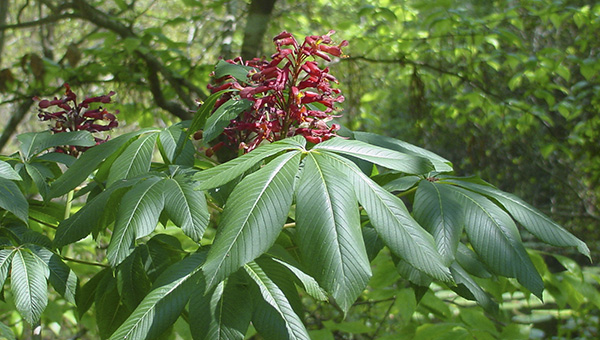Arboretum Paths: Listen for the hum of the hummingbird
Published 7:00 am Wednesday, July 22, 2015

Red buckeye, an easy-to-grow small native tree, can be found in the Arboretum’s Woodland Exhibit (Photo by Melinda Lyman).
Have you ever heard the hum of a hummingbird? Believe it or not, I had never had the chance to hear that awesome sound until a few years ago, when I was invited to the home of one of our longtime members to pull up a chair and sit a spell to watch the show, as a dozen or so of these enchanting birds battled over the feeders. It was truly better than television!
Some people will regularly fill feeders with a nectar mixture purchased from the garden center, or cook up their own sugar-water solution. But this is a practice best suited to the dedicated individual who is willing to regularly replace the solution in order to avoid birds becoming ill from drinking bacteria-laden solution.
Why not forget about feeders altogether? There are many delightful native plants for your garden that will not only be attractive in the landscape, but will serve to attract hummingbirds. Read more about these plants and then look for them at an Arboretum plant sale, or visit your local garden center.
Spring-blooming red buckeye is a favorite of hummingbirds. This small tree prefers moist soils and will grow in part shade to full sun. The tree will appreciate some shifting shade. Keep in mind that if the soil tends to dry out the leaves will be susceptible to withering. Red buckeye is a great “passalong” plant as it is a very easy tree to propagate, with fresh seed usually germinating in a week or two.
Coral honeysuckle, also known as trumpet honeysuckle, is a summer-blooming vine that works well on a trellis, fence, or arbor. Full sun promotes best flowering, but the plant will tolerate partial sun and attracts both hummingbirds and butterflies. If you should come across a mature vine in full bloom in the wild, it is not an easy sight to forget. A few years ago I spotted just such a plant on nearby Asa McQueen Road here in Pearl River County. It was a massive vine that hung out over the road from tall tree branches, loaded with the red tubular flowers. What a sight!
Cardinal flower is a native perennial with showy red bloom spikes in summer. I’ve also seen it growing in the wild along coastal Mississippi stream banks, in full sun to part shade, although it tends to look and do its best when it has a bit of shade. Cardinal flower prefers soils that are consistently wet, and it will attract butterflies as well as hummers.
Every year, we hear reports from people who are excitedly making their plans to attend a big migration celebration for ruby-throated Hummingbirds. This three-day event is held in early September at the Strawberry Plains Audubon Center in Holly Springs, Mississippi, located about an hour south of Memphis. Thousands of people attend this annual festival, learning about the birds through the many walks, lectures, and demonstrations such as banding activities.
Before you dig a hole to put any new plant in the ground, it is important to understand the site conditions it prefers. Will you be giving it the correct exposure of sun or shade? Does it prefer to live in a well-drained soil? Some plants might prefer moist soil conditions, but require good drainage, while others tolerate heavy soils with poor drainage and even periodic or permanent standing water. Another important question to ask yourself is what function the plant will serve?If it can do double-duty, that’s even better. For example, a plant that attracts wildlife might also provide a great screen for your property line.
Come to an “All About Hummingbirds” program with James Bell on Saturday, July 25 from 10 to 11 a.m. James will reveal how you can fill your yard with hummingbirds, and will present tips and tricks to fill your yard with hummingbirds. Learn about the life and habits of hummingbirds, how they feed, and why we see them fighting so much. James will discuss plants you can add to your garden that will draw these birds, and other methods that will ensure you will see more “hummers”. Program is suited to ages 8 and up. Members free, non-member adults $5, children $2. Please call 601-799-2311 to sign up.
The Arboretum is open Wednesdays through Sundays from 9 a.m. to 5 p.m. and located in Picayune, off I-59 Exit 4, at 370 Ridge Road (south of Walmart and adjacent to I-59). For more information about our programs and events, see the website at www.crosbyarboretum.msstate.edu.
FOR FURTHER EXPLORATION: The MSU Extension website at www.MSUcares.com and enter the keyword “hummingbirds” to read information on these delightful birds, such as “Attracting Hummingbirds to Mississippi Gardens”, an article that summarizes hummingbird behavior, and ways to attract them, as well as lists of plants for your garden. More information can be found in Extension publication 2402 on “Establishing a Backyard Wildlife Habitat”, which contains many lists of native and ornamental plants to attract birds and other wildlife to your yard. You may download and save this publication to your computer.
By Patricia Drackett





